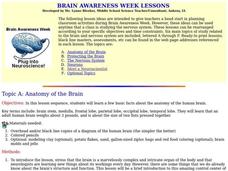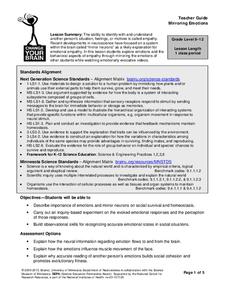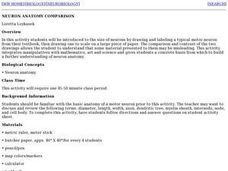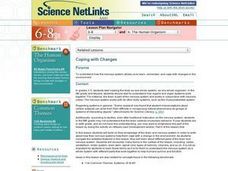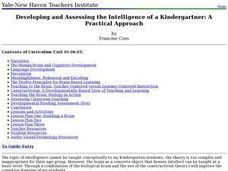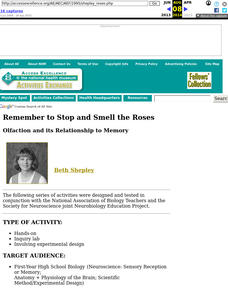Curated OER
Building a Clay Neuron
Students examine the anatomy of a neuron and its physiology. In this neuron lesson students build a representative model of a biological structure.
Curated OER
All About the Brain
Young scholars use eggs, cooking oil, foam balls and more to create a simulation of the brain and record what happens in each step. In this brain lesson plan, students learn about protecting the brain, the brain's ability to learn, and...
Curated OER
Brain Awareness Week
Students explore the brain. In this science lesson, students create a model of the brain and discuss steps taken in order to protect the brain. Students design a container that would protect the brain from injury. Students discuss the...
University of Minnesota
Mirroring Emotions
Do you ever give your class the "teacher look"? Without saying a word, they become silent and engaged (hopefully). How do they know what you're thinking? Explore the concept of nonverbal communication and how it relates to our mirror...
Curated OER
Remember This?
Students investigate the mechanics of an fMRI and the properties of neurons. In this biology lesson, students analyze the way the brain works by performing tests in the neurons in the brain. This is all done theoretically.
Curated OER
Neuron Anatomy Comparison
Pupils create a scale model of a motor neuron that is two hundred times larger than the actual neuron. They identify the structures of a neuron and observe neurons under the microscope then use a worksheet to convert actual sizes into...
Curated OER
Teaching Neuro-anatomy Through Schematic Diagrams
Students develop a deeper understanding of the brain. In this neuro-anatomyl lesson plan, students will use simple diagrams to understand the brain and will progress to more complex diagrams as they gain understanding.
Curated OER
Coping with Changes
Students build on knowledge of brain and nervous system in order to write about how their nervous systems help them cope with change in environment. Students navigate online sites to explore different parts of brain and nervous system.
University of Minnesota
Dendritic Spines Lab
This is your brain on drugs ... literally! Your neuroscientists-in-training examine the evidence of drug use on the human brain and how neurons change their connectivity when altered by drugs. They then work together to create testing...
Curated OER
Building a Clay Neuron
Learners investigate and then build neurons in this lesson. They are examined as key parts of the brain and nervous system and seen as different from normal cells.
Curated OER
Making a Brain: Aritifical Neural Network
Students explore how the brain works. In this nervous system activity, students create a network of "neurons" to simulate how the nervous system and the brain work together.
Curated OER
Drugs Change the Way Neurons Communicate
Students examine that certain drugs interfere selectively with neurotransmission, and realize that the effect of a drug is dependent upon dosage and route of administration.
University of Minnesota
Neuropathfinding: Kinesthetic Model
Playing follow the leader has never been so interesting! Get the class up and moving while they take on the roles of nervous system components. Through trial and error, they learn the importance of the "pioneer" growth cone that leads...
University of Minnesota
Ways of Knowing: Apples as Models
Use apples as a way of thinking about models. Young scientists consider how the word apple, a two-dimensional drawing, a three-dimensional image, a photograph, and plastic apples all model real apples in preparation for developing models...
Curated OER
It's All in Your Mind
Students study the characteristics that an elderly person may develop in their life. In this brain changes lesson students evaluate activity status to determine if changes need to be made to promote a healthy brain later in life.
Curated OER
Developing and Assessing the Intelligence of a Kindergartner: A Practical Approach
Students name objects that are the same size, shape, and weight as the human brain. They touch the model brain, feeling the folds, etc. They make connections to the chart displaying the brain-like objects. They touch the 'potato flake'...
Curated OER
How Alzheimer's Affects the Brain
Students study how Alzheimer's affects different parts of the brain, sketch a healthy neuron and its parts, and diagram brain changes during the early and late stages of Alzheimer's.
Curated OER
Brain Watching
Students identify the different parts of the nervous system. In this biology lesson, students research methods to diagnose and cure neurological disorders. They present their report to class.
Curated OER
The Nervous System
Students investigate the nervous system. In this anatomy instructional activity, students identify and define vocabulary related to the nervous system. Students role play the parts of a nervous system and perform an experiment measuring...
Curated OER
Remember to Stop and Smell the Roses: Olfaction and its Relationship to Memory
Students discover that olfaction elicits memory associations. They investigate how olfaction compares to other sensory modalities in the formation of memories. This is a hands-on lab activity guaranteed to build memories in your students!
Curated OER
Mapping the Homunculus
Students determine the relative number of nerve endings located in the skin. By calculating the reciprocal of these measurements, students have the appropriate data for predicting the relative size of the homunculus found on the cerebral...
University of Minnesota
Neurotransmission Model
Don't lose your marbles — you'll need them for a lesson on neurotransmission. Young scholars build a neurotransmission model using marbles, beads, rubber bands, string, and other elements. After studying specific neurotransmitters,...
Teach Engineering
Processes on Complex Networks
Introduces your class to random processes in networks with an activity that uses information about disease spread using the susceptible, infectious, resistant (SIR) model. Participants determine whether a susceptible person becomes...
Teach Engineering
Complex Networks and Graphs
Show your class how engineers use graphs to understand large and complex systems. The resource provides the beginnings of graph theory by introducing the class to set theory, graphs, and degree distributions of a graph.




